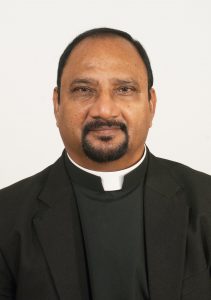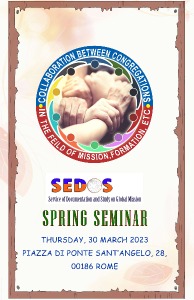
Dear Members and Readers,
Reflecting on the need for inter-congregational co-operation, the SEDOS team came together to discuss and explore more possibilities of working together. Thus, the topic, “Collaboration Between Congregations in the Field of Mission and Formation”, was chosen to begin with. Besides mission and formation there are a number of fields, where the congregations can work together in order to be more effective and relevant in the present context, where a number of congregations are struggling to survive.
Talking about the success of co-operation, Kärin Butler Primuth and Michael Kaspar, the Catalysts for the Ministry Collaboration Issue Network, at the Global Workplace Forum 2019 held in Manila, the Philippines, said: “These mission networks, in all their various forms – as partnerships, alliances, or coalitions, bring churches, ministries, mission agencies, field workers, tent makers, business entrepreneurs, and fund raisers together around common areas of interest to share information and resources, learn from each other, and co-operate in joint projects to accomplish what no one could do alone.”
Reflecting upon the theme, whose basis can be found in Scripture. Co-operation among members within the Body of Christ is vitally important as it reflects the very nature and dynamism of the Triune God.
Furthermore, Kärin Butler Primuth and Michael Kaspar say, “Not only is collaboration important because it reflects God’s design for his Body, but also because co-operation has demonstrated increased Kingdom impact. Over the last 40 years, God has been uniting the global Church as never before in history, resulting in the explosive growth of mission networks that are making the Gospel advance where the challenges are too great, the situations too complex, and the resources required are too much for any single organization or strategy to face alone.”
During the Seminar we heard the sharing of some groups co-operating and making an impact on Global mission. Today we can find hundreds of networks rallying around shared goals in dozens of different mission fields – from people in groups to geographically or specifically focused issues.
In the current SEDOS Bulletin, you will see that the missionary congregations are concerned about networking. All are looking forward to working jointly on some specific areas such as mission and formation. They delve into these two areas to explore the possibilities of co-operation.
These practical examples of co-operation among Congregations in Mission and Formation is particularly appropriate at this time when the whole Church is embarking, at the invitation of Pope Francis, on a synodal journey. The consecrated are invited to take this synodal process seriously and become an irreplaceable part of the great community on the move, that is the Church.
The present SEDOS Bulletin is actually the outcome of the SEDOS Spring Seminar that was held at the UISG on 30 March 2023 on the theme, “Collaboration Between Congregations in the Field of Mission and Formation.” The Bulletin begins with the Introductory talk given by Mary Barron, Superior General of OLA, in which she put the theme in the right perspective and gave the right orientation to the topic.
The first article entitled, “Missio Dei Is Missio Trinitas: Sharing the Whole Life of God, Father, Son and Spirit” was not part of the Seminar but it gives the theological and Biblical foundation of co-operation. In this article Darren Cronshaw gives us a theological foundation of co-operation based on the Trinity.
The Second article by Nadia Coppa, ASC, based on the paper she presented at the SEDOS Spring Seminar on the theme, “Collaboration between Congregations in the Field of Formation and Mission”, put before us the opportunities and challenges related to co-operation among Congregations.
In the Third article, also based on the paper presented on the theme, “Laici: collaboratori nella missione e coinvolgimento nella Chiesa locale”, Adelson Araújo dos Santos, SJ, invites us to cooperate with the laity and make the Church more vibrant.
The fourth article, jointly presented at the panel discussion during the same Spring Seminar, by Francis Rozario, SMA, and Juliana Karomba, MSOLA, on the theme, “Inter-Congregational Partnership” based on their experience of an inter-congregational venture in “Inter Congregational Ongoing Formation (ICOF).”
The fifth article, also part of the panel discussion during the SEDOS Spring Seminar, presented by Jim Greene, M. Afr., on “Collaboration between Congregations for Mission”, where he explains the various challenges faced and dealt with in working with sixteen congregations on the project for Solidarity in South Sudan. In his concluding remarks, Jim says, that they offer a model which shows “different cultures living in harmony and working together for a common good that serves all.”
In the last article, Alberto Lamana, MCCJ, his presentation during the panel discussion, spoke about his experience with the group, Tutti Fratelli, a group of Religious Brothers residing in Rome. They represent various Institutes and gather regularly to exchange and promote common initiatives relevant to their respective Congregations. For Alberto, “The group is an expression of synodality that is an essential dimension of today’s Church.”
Lastly, we are publishing a long-awaited review on the book, “New Trends in Mission” by James H. Kroeger, MM, under the title, “Mission: Our Continuing Journey.”I am sure that all these articles will enlighten us and motivate us to work together not only in the field of mission and formation but also in other areas such as spirituality, ecology, peace, justice and community life.
Dr. John Paul Herman, SVD
Director of SEDOS


